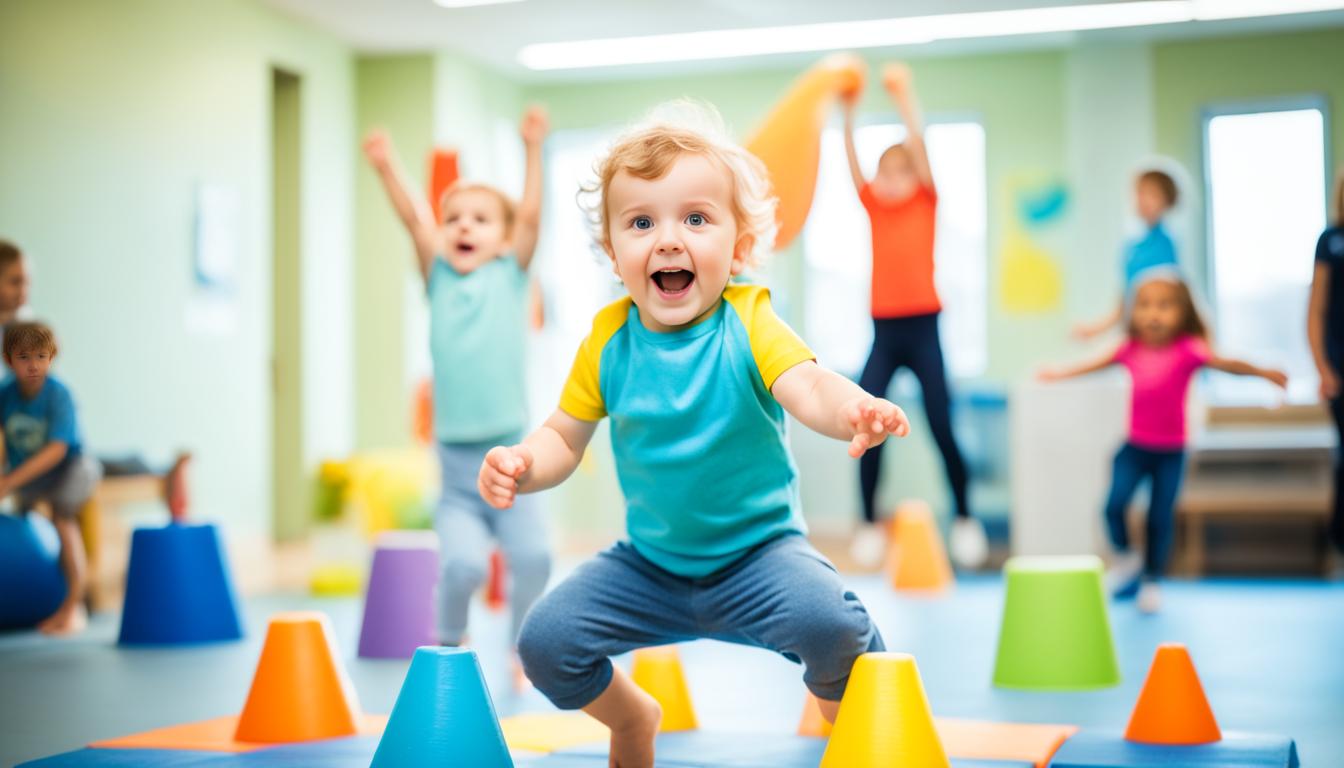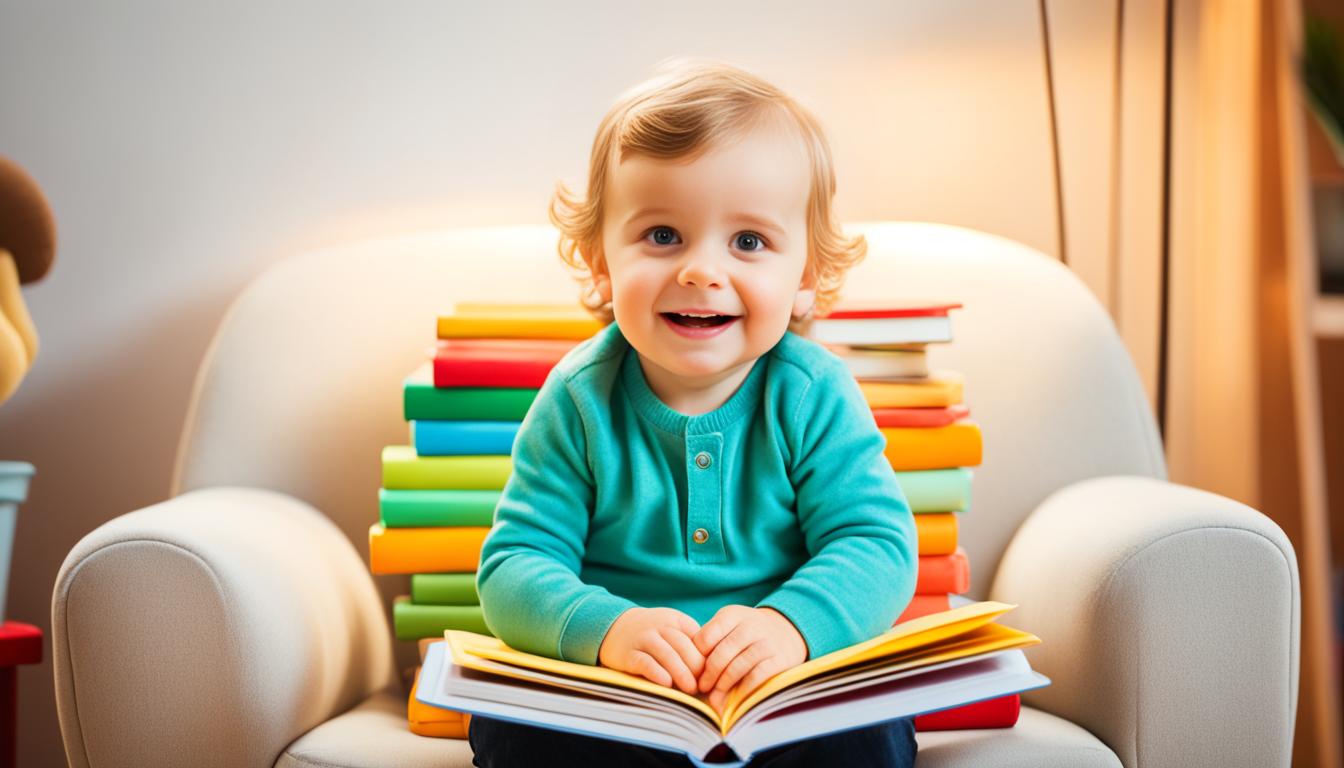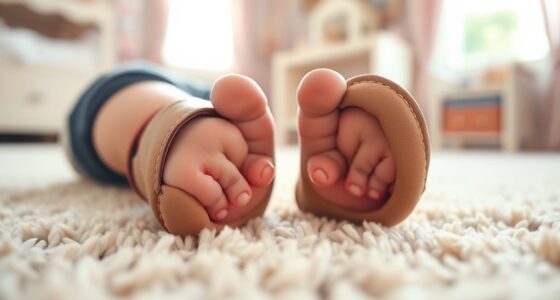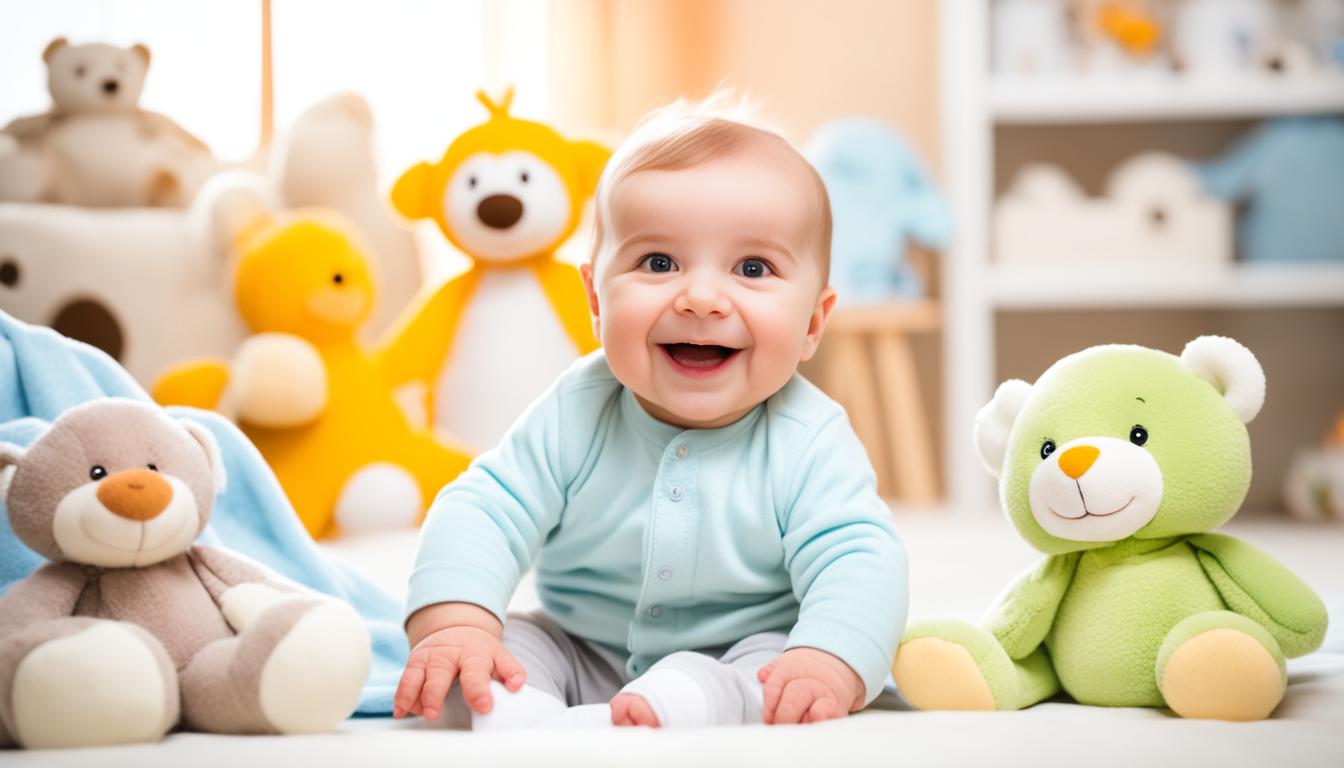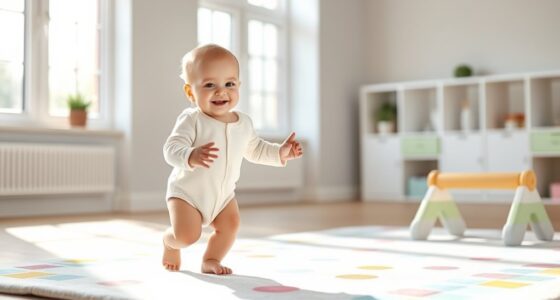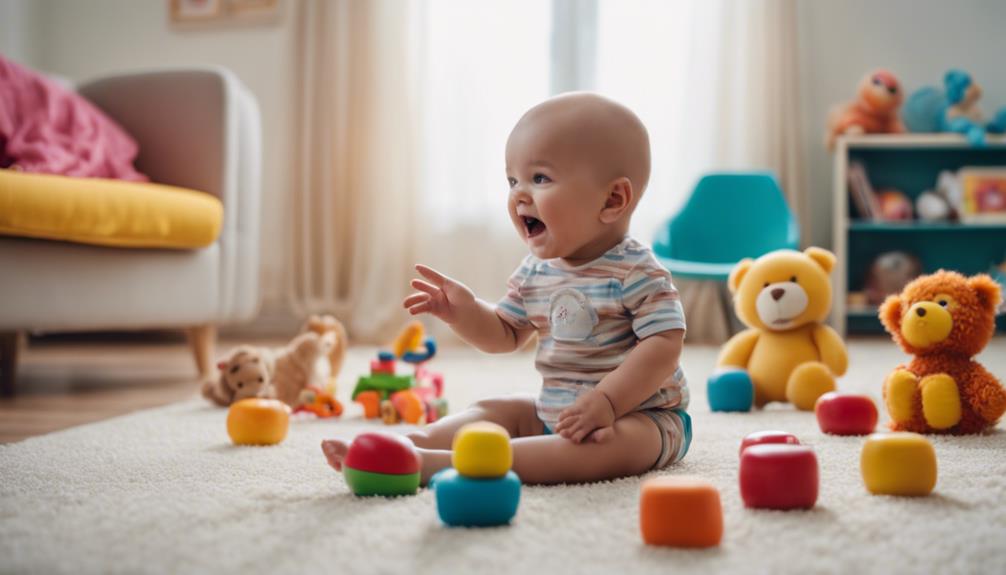Developing gross motor skills is crucial for your toddler’s physical development. These skills involve utilizing large muscle groups in the body and are responsible for activities like walking, running, jumping, and climbing. As your toddler matures, their muscles strengthen, enabling them to partake in more intricate physical movements and enhance gross motor skills that are essential for daily functions and sports activities.
Imagine this: It’s a sunny afternoon, and you take your toddler to the playground. As they climb up the ladder to the slide, you notice how their balance, coordination, and core strength come into play, enabling them to navigate the playground equipment with confidence and ease. Watching them reach new heights and conquer new challenges fills you with pride and joy, knowing that their gross motor skills are developing2.
Developing gross motor skills not only impacts your toddler’s ability to participate in physical activities but also plays a significant role in their academic learning. Studies have shown that there is a strong link between gross motor skills and cognitive development2. By engaging in activities that promote gross motor skill development, you are not only supporting your child’s physical growth but also enhancing their overall coordination, strength, and balance2. It’s a win-win!
Key Takeaways:
- Gross motor skills are crucial for everyday functions, playground skills, and sporting skills, which impact academic learning2.
- Developing gross motor skills involves building blocks such as muscular strength, endurance, motor planning, sensory processing, balance, and coordination2.
- Children with gross motor difficulties may experience delays in reaching milestones, lack fluid body movement, struggle to follow instructions, and tire frequently2.
- Gross motor difficulties can also affect activities such as drawing, writing, posture maintenance, sensory processing, and speech articulation2.
- Improving attention, core strength, breaking down physical skills into steps, enhancing endurance, and employing cognitive planning strategies are recommended to enhance gross motor skills2.
- Activities such as hopscotch, wheelbarrow walking, unstable surfaces walking, catching and balancing exercises, obstacle courses, and playground climbing can help improve gross motor skills2.
- Seeking therapy for gross motor difficulties is important to boost a child’s confidence, self-esteem, sporting abilities, and support fine motor skills development2.
- Untreated gross motor difficulties can lead to challenges managing a full school day, participating in sports, diminished self-esteem, potential bullying, and poor fine motor skills2.
- Occupational therapy is recommended for children with gross motor skill difficulties, but consulting with a physiotherapist may also be beneficial2.
Components of Gross Motor Skills
Gross motor skills encompass various components that contribute to a toddler’s physical development and abilities. These components include:
- Balance: The ability to maintain equilibrium and stay upright while stationary or in motion.
- Muscle Strength: The power and force generated by the muscles to perform movements.
- Coordination: The integration of various body parts and muscle groups to execute smooth and controlled movements.
- Muscle Endurance: The ability of the muscles to sustain activity over a period of time.
- Motor Planning: The ability to plan and organize movements before executing them.
- Body Awareness: The understanding and perception of one’s body and its position in space.
- Weight Shifting: The ability to redistribute body weight to maintain stability and balance during different movements and activities.
These components work together synergistically to support the development of gross motor skills in toddlers. Achieving milestones in gross motor skills is crucial for children’s overall physical development and lays the foundation for future movement capabilities.
Muscular strength is a key building block for developing gross motor skills2.
Motor planning is crucial for executing bodily movements with refined control2.
Sensory processing plays a significant role in responding to environmental stimuli2.
Importance of Gross Motor Skills in Early Childhood
Gross motor skills play a crucial role in the overall development of young children. These skills, which involve the use of large muscle groups, enable children to participate in essential daily activities such as walking, climbing stairs, and carrying objects. Gross motor skills provide a foundation for fine motor skill development by enhancing core strength and stability, which are necessary for tasks like writing and drawing3.
In addition to enabling basic physical functions, gross motor skills significantly impact a child’s coordination, fitness levels, and overall well-being. When children have well-developed gross motor skills, they can engage in various physical activities with ease, maintaining an active and healthy lifestyle4. Furthermore, promoting the development of gross motor skills in early childhood sets a strong foundation for success in other areas of life, such as academic performance, social interactions, and sports participation3.
It is crucial to recognize that the development of gross motor skills can be influenced by various factors. Genetic factors, health issues like cerebral palsy, speech delays, and environmental factors can contribute to delays or difficulties in gross motor skill development3. These delays may manifest differently depending on whether they affect fine motor skills or gross motor skills specifically. Fine motor skill delays can present as difficulties in manipulating small objects, poor hand-eye coordination, and challenges with tasks like coloring, writing, or tying shoelaces. On the other hand, gross motor skill delays may be observed as poor balance, difficulties in activities like running or climbing stairs, and lack of stamina during play3.
Motor planning is an essential aspect of gross motor skill development, especially regarding fine motor skills. It involves the ability to plan, sequence, and execute motor tasks using visual, kinesthetic, and proprioceptive senses. Developing motor planning skills is crucial for facilitating the acquisition of fine motor skills, which rely on precise coordination and control3.
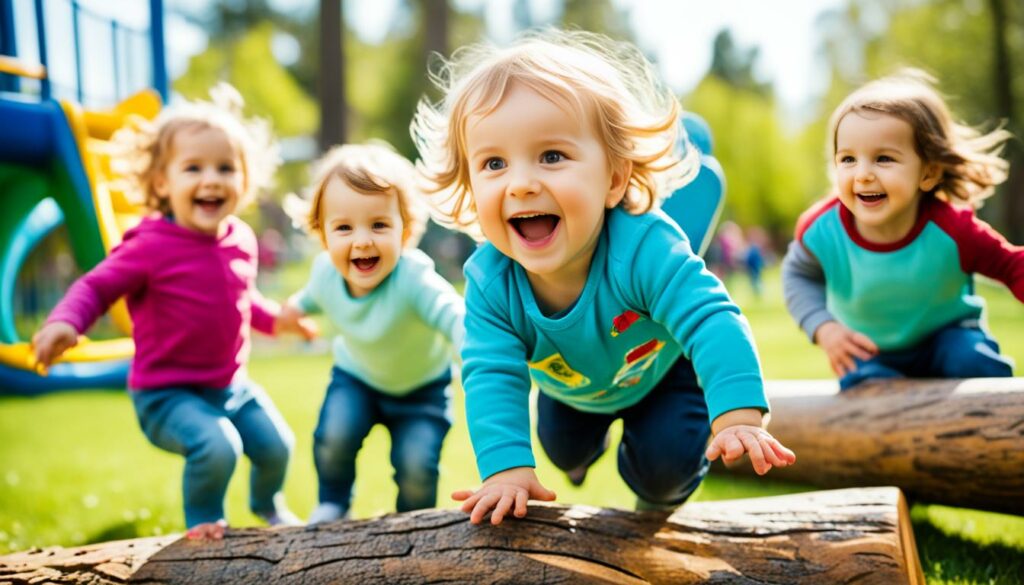
Statistical data from various studies supports the importance of promoting gross motor skills in young children. For example, research has shown that preschoolers who participate in physical activity interventions experience improvements in their fundamental motor skills, with a specific focus on gross motor skills. These interventions contribute to enhanced physical fitness, coordination, and motor planning abilities4. Studies have also emphasized the critical role of outdoor playing time in enhancing motor skills among preschoolers, underscoring the value of active engagement with the environment4. Outdoor play provides opportunities for children to practice and develop their gross motor skills while enjoying the benefits of fresh air and physical exercise.
In conclusion, gross motor skills are of paramount importance in early childhood. They enable children to engage in daily activities, support the development of fine motor skills, and contribute to overall physical fitness and well-being. By promoting the development of gross motor skills in young children, we lay the foundation for their success and growth in various aspects of life.
Tips for Enhancing Gross Motor Skills in Toddlers
Enhancing gross motor skills in toddlers is an essential part of their physical development. By providing them with opportunities to engage in various activities, you can support their coordination, strength, and balance. Here are some tips to help enhance your toddler’s gross motor skills:
- Encourage active play: Engage your toddler in activities that involve movement, such as running, jumping, and climbing. This helps them practice muscle usage and enhances their overall gross motor skills5.
- Provide outdoor opportunities: Outdoor play allows toddlers to explore their environment and engage in activities that promote gross motor skill development. Take them to the park or backyard and let them run, kick a ball, or ride a tricycle2.
- Introduce balance exercises: Activities that require balancing, such as walking on a tape line or navigating through an obstacle course, can help improve your toddler’s balance and coordination6.
- Include throwing and catching: Play games that involve throwing and catching objects, like balloons or soft toys. This improves hand-eye coordination and enhances gross motor skills6.
- Engage in interactive play: Games like tag or Simon Says can encourage your toddler to perform different movements, promoting their body coordination6.
Remember, each child’s development is unique, so it’s important to provide a supportive and encouraging environment tailored to their individual needs. By incorporating these tips into their daily routine, you can help your toddler enhance their gross motor skills and lay a strong foundation for their overall physical development.
Milestones and Individual Differences in Gross Motor Skills Development
Children develop gross motor skills at different rates, and there are general milestones for specific age ranges. However, it is important to understand that individual differences are common. Some children may achieve these milestones earlier or later than others. It is crucial to focus on your child’s progress and provide opportunities for practice and development based on their individual needs. If you have any concerns about your child’s gross motor development, it is recommended to seek professional advice from a pediatric occupational therapist or healthcare provider.7
Throughout the early years, children reach various gross motor milestones that indicate their progress in physical development. These milestones encompass a wide range of abilities and skills. For example, by the age of two months, children should start lifting their head during tummy time and pushing up onto forearms, as well as closing their fingers in a tight grasp and holding onto a rattle with one hand briefly8. As they continue to grow, at five months, children begin rolling from belly to back and shifting their weight to reach while on their tummies, along with bringing their hands to their feet while on their backs8.
As toddlers approach their first birthday, they achieve significant gross motor milestones. Crawling on hands and knees, transitioning from sitting to a quadruped position, and pulling to stand up with support are typical skills developed by eight months8. By 15 to 18 months, children can ascend stairs with assistance, stack 2-3 cubes, and draw vertical lines8. Developmental milestones for 2-3 years include balancing on one leg for a few seconds, ascending stairs with an alternating step pattern, stacking 8-10 cubes, and drawing a circle8.
By the time children reach 4-5 years old, they have acquired more advanced gross motor skills. They can hop on one foot, balance on one leg for longer periods, skip, draw squares, cut out simple shapes on paper, and have established their preferred hand for use8. These milestones showcase children’s progress in gross motor skills and provide a framework for evaluating their development.
Understanding both the general milestones and individual differences in gross motor skills development allows parents and caregivers to track their child’s progress effectively. It is important to remember that these milestones are intended as guidelines, and each child develops at their own pace. Providing a supportive environment and engaging children in age-appropriate, physical activities can help foster their gross motor skills and overall physical development.
Signs of Gross Motor Skill Difficulties in Toddlers
As a parent, it is important to be aware of potential signs of gross motor skill difficulties in your toddler. These signs can help you identify if your child may be experiencing delays in their physical development. Some indicators to watch for include:
- Delays in reaching developmental milestones: If your toddler is not sitting, crawling, walking, or running within the expected age range, it may be a sign of a gross motor skill delay9.
- Stiff or clumsy movements: Difficulty with coordination and movement can indicate underlying gross motor skill difficulties10.
- Avoidance of physical activities: If your child consistently avoids activities that require gross motor skills, it could be a sign of challenges in this area11.
- Short periods of physical activity due to low endurance: If your toddler quickly becomes tired or fatigued during physical play, it may be a result of poor endurance9.
- Inability to perform the same skills as peers: Difficulty keeping up with peers in terms of gross motor skill development may indicate a delay10.
- Difficulties with balance and coordination: If your child struggles to maintain balance or coordinate their movements, it may be a sign of gross motor skill difficulties11.
If you notice any of these signs or have concerns about your child’s gross motor skills, it is recommended to consult with a healthcare professional for further evaluation. They can provide guidance, assessments, and interventions to support your child’s physical development and ensure they receive the appropriate assistance if necessary.
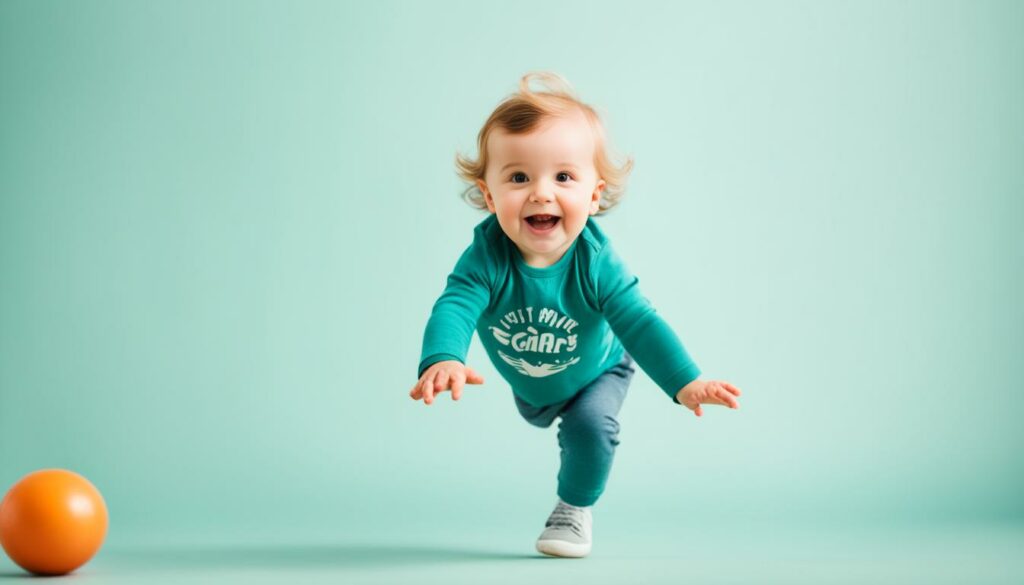
| Gross Motor Skill Difficulties | Likely Causes |
|---|---|
| Delayed reaching developmental milestones | |
| Stiff or clumsy movements | Motor delays possibly caused by conditions like cerebral palsy or myopathy10 |
| Avoidance of physical activities | Possible underlying gross motor skill difficulties11 |
| Short periods of physical activity due to low endurance | Motor skill delays impacting endurance9 |
| Inability to perform the same skills as peers | Possible causes such as cognitive delays or conditions like cerebral palsy10 |
| Difficulties with balance and coordination | Possible indications of motor delays and challenges with coordination11 |
By staying vigilant and recognizing these signs, you can take proactive steps to support your child’s physical development and provide them with the necessary interventions if needed. Remember, every child develops at their own pace, but early identification and intervention can help address any potential issues and ensure your child reaches their full potential.
Impact of Gross Motor Skill Difficulties and Related Problems
Gross motor skill difficulties in toddlers can have a significant impact on their overall development and daily activities12. These difficulties can affect a child’s ability to participate fully in school, sports, and self-care tasks12. They may struggle with activities that require coordination, balance, and endurance12. These challenges can also impact fine motor skills, such as using utensils or writing, as well as posture, energy levels, sensory processing, and speech articulation12.
Studies have shown that poor gross motor skills in children with learning disabilities can be associated with delays in academic areas such as reading and math13. Early intervention for gross motor skill delays is crucial as they can impact a child’s cognitive and motor abilities as they grow older13. Developing strong gross motor skills is essential for major body movements like walking, maintaining balance, coordination, and reaching, which are fundamental for daily activities and academic success13.
Addressing gross motor skill difficulties through therapy and targeted interventions can provide support in improving motor skills, confidence, self-esteem, and overall functional abilities12. Therapists can work with toddlers to enhance their coordination, balance, and physical abilities, enabling them to participate more fully in various aspects of their lives12. Seeking professional help is recommended to ensure optimal development and well-being for children facing gross motor skill difficulties12.
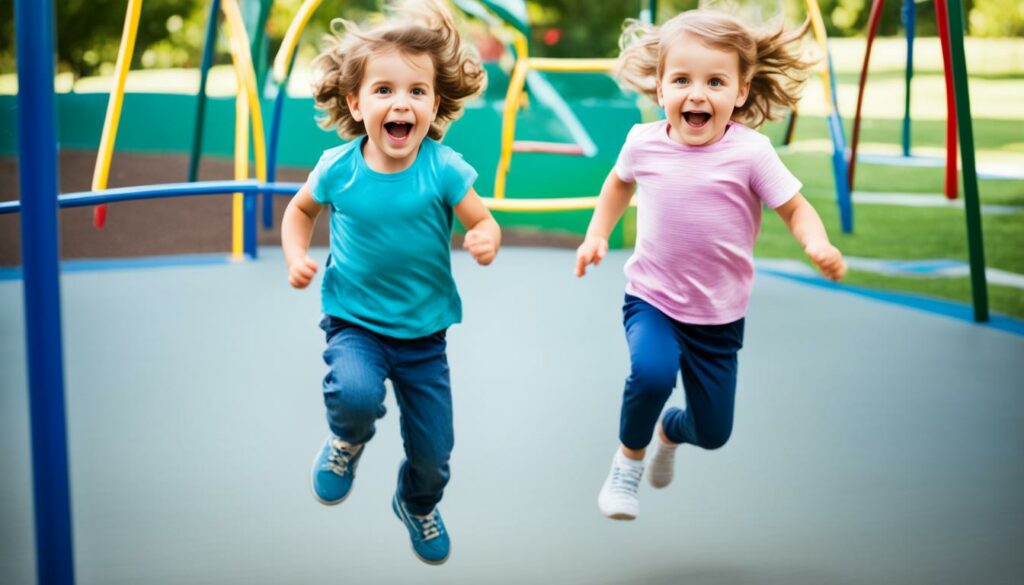
Therapeutic Interventions and Activities to Improve Gross Motor Skills
Occupational therapy is often recommended to address gross motor skill difficulties in toddlers. This therapy helps improve attention, core strength, sensory processing, motor planning, and coordination2. Therapists utilize various techniques and activities to enhance gross motor skills, such as hopscotch, wheelbarrow walking races, catching and balancing exercises, and obstacle courses2. They may also focus on promoting sensory processing and cognitive planning strategies to facilitate skill development2. Therapy offers tailored interventions to support your child’s specific needs and promote optimal gross motor skill development2.
One effective approach to enhancing gross motor skills is through engaging in activities that challenge and support these skills. For indoor activities, games like Simon Says and dancing can enhance body awareness, movement planning, balance, and coordination14. Outdoor activities, on the other hand, provide opportunities for children to utilize their gross motor skills in a natural environment. Utilizing chalk for drawing, creating balance beams, playing hopscotch, and engaging in obstacle courses can all contribute to the development of gross motor skills14.
Outdoor activities can also include making a racetrack, playing hopscotch games, creating a backyard Twister, enhancing ball skills, playing catch, gardening, and outdoor exploration14. These activities target specific areas such as balance, coordination, muscle strength, motor planning, and sensory processing, contributing to the overall development of gross motor skills14.
| Therapeutic Interventions and Activities |
Source (Research Study) |
|---|---|
| Hopscotch, wheelbarrow walking races, catching and balancing exercises, obstacle courses | Sutapa P. et al., 2020 |
| Simon Says, dancing | Gümüşdağ H., 2019 |
| Utilizing chalk for drawing, creating balance beams, playing hopscotch, and engaging in obstacle courses | Yarimkaya E., Ulucan D.D.H., 2014 |
| Making a racetrack, hopscotch games, creating a backyard Twister, enhancing ball skills, playing catch, gardening, outdoor exploration | Moghaddaszadeh A., 2021 |
Engaging in these activities with your child can provide them with opportunities to strengthen their gross motor skills while having fun14. It is important to remember that every child is unique and may have different strengths and areas for improvement. Offering a variety of activities that cater to their specific needs and interests will contribute to their overall progress in developing gross motor skills214.
By incorporating therapeutic interventions and engaging activities into your child’s routine, you can help enhance their gross motor skills, promoting their physical development and overall well-being24. Occupational therapy provides specialized support and guidance to address your child’s specific needs, enabling them to reach their full potential in gross motor skill development2. Remember, seeking early intervention and professional assistance can make a significant difference in your child’s journey towards improved gross motor skills24.
Conclusion
Enhancing gross motor skills in toddlers is crucial for their physical development and overall well-being. By incorporating fun and engaging activities into their daily routines, parents can support their child’s gross motor skill development15. Engaging in physical activities like dancing and swimming can improve coordination, balance, and strength, essential factors in gross motor skill development15. Limiting screen time for children and promoting physical activities has been linked to increased cognitive development and overall physical health, which contributes to enhancing motor skill development15.
Toddlers should accumulate at least 60 minutes of structured physical activity daily16. Additionally, they should engage in at least 60 minutes – and up to several hours – per day of unstructured physical activity and should avoid being sedentary for more than 60 minutes at a time16. Providing opportunities for both structured and unstructured physical activities is essential for toddlers’ gross motor skill development16.
Remember that each child develops at their own pace, so it’s important to focus on individual progress and seek professional help when needed15. With the right support and guidance, toddlers can enhance their coordination, balance, strength, and overall physical abilities, setting a strong foundation for lifelong healthy movement and physical development15. By prioritizing and nurturing their gross motor skills, parents play a vital role in their child’s physical development journey.
FAQ
What are gross motor skills?
Why are gross motor skills important for toddlers?
How can I enhance my toddler’s gross motor skills?
What are the milestones for gross motor skills development in toddlers?
What are the signs of gross motor skill difficulties in toddlers?
How do gross motor skill difficulties impact a toddler’s development?
What therapeutic interventions and activities can improve gross motor skills in toddlers?
How do individual differences impact gross motor skills development in toddlers?
Why is it important to seek professional help for gross motor skill difficulties in toddlers?
How does enhancing gross motor skills benefit a toddler’s overall development?
Source Links
- https://www.happiestbaby.com/blogs/toddler/gross-motor-activities-toddlers
- https://childdevelopment.com.au/areas-of-concern/gross-motor-skills/gross-motor-activities/
- https://circlecare4kids.com/the-importance-of-motor-skills-in-child-development/
- https://www.ncbi.nlm.nih.gov/pmc/articles/PMC8625902/
- https://kidsatmax.com.au/10-fun-ways-improve-gross-motor-skills-2/
- https://www.canr.msu.edu/news/building_gross_motor_skills_and_why_it_matters
- https://www.chrichmond.org/services/therapy-services/developmental-milestones/gross-motor-skills-birth-to-5-years
- https://www.lifespan.org/lifespan-living/childrens-developmental-milestones-gross-and-fine-motor-skills
- https://www.webmd.com/parenting/baby/recognizing-developmental-delays-birth-age-2
- https://nyulangone.org/conditions/developmental-delays-in-children/types
- https://my.clevelandclinic.org/health/diseases/14814-developmental-delay-in-children
- https://nhsforthvalley.com/wp-content/uploads/2019/04/Gross-Motor-Skills-5-11.pdf
- https://www.verywellfamily.com/what-are-gross-motor-skills-2162137
- https://napacenter.org/gross-motor-skills-summer/
- https://kidscarehomehealth.com/motor-skill-development-a-comprehensive-guide/
- https://altapediatrics.com/resources/education-center/gross-motor-skills/

